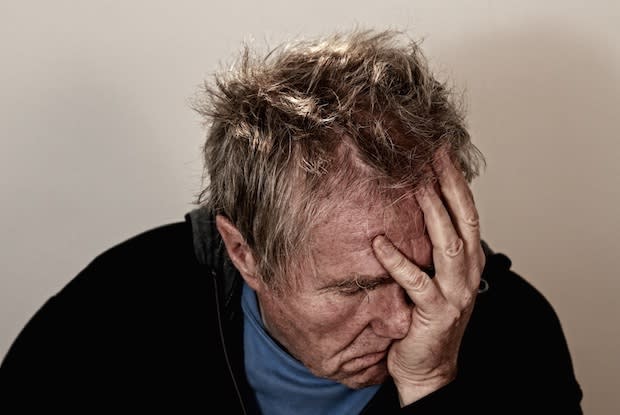Table of Contents
V. Seasonal Affective Disorder
VII. Other Types of Depression
What is Depression?
It is common to have times in your life when you feel upset or hopeless. For people with depression, these feelings occur almost daily for an extended period of time. Depression is a recognized mood disorder that affects more than 17 million adults in the United States. [1]
Depression affects a patient’s mind and body, causing persistent feelings of sadness, hopelessness, guilt, and worthlessness. Depression can also cause symptoms including fatigue, memory problems, headaches, and loss of interest in hobbies. This condition is often treated using antidepressant medications such as Prozac (fluoxetine), Cymbalta (duloxetine), and Wellbutrin XL (bupropion) to relieve the symptoms of depression. There are many different types of depression. Keep reading to learn about the most common forms of this condition.
Major Depression
Major depression (also called major depressive disorder, clinical depression, and classic depression) is a common mental health disorder. When many people think of depression, they often think of major depression. Over 16 million Americans have experienced at least one episode of major depression. [2]
Major depression is a severe form of depression. While some people may only have a single episode of this depression, other patients may regularly experience it throughout their lives. Symptoms of major depression include a loss of interest in activities, sleeping problems, feelings of worthlessness, and an inability to see a positive solution. Your doctor may diagnose you with major depression if you have these symptoms most days for two or more weeks. [3] Severe forms of this depression can lead to suicidal thoughts or actions. [4]
You should speak to your doctor if you notice any of these symptoms. There is not always an obvious reason for major depression. Speaking to your doctor can help diagnose and treat the condition.
Persistent depression (also known as persistent depressive disorder, chronic depression, and dysthymia) is a form of depression that lasts two years or longer. This form is often not as intense or severe as major depression but can still have major effects due to its longevity. Around 1.3 percent of adults in the U.S. will suffer from persistent depression during their lives and the disorder is more common in women than men. [5] For many patients, the severity of symptoms of persistent depression will repeatedly worsen and improve during their condition. Since persistent depression lasts for several years, patients may feel that their symptoms are just part of their regular life. Common symptoms can include low self-esteem, social withdrawal, fatigue, and concentration problems. [2] Often, persistent depressive patients may also suffer an episode of major depression. This is known as double depression and can cause worsening symptoms of depression. [6] Bipolar disorder (formerly known as manic depression) is a condition where patients go through periods of mania and depression. These extreme fluctuations affect your mood, thinking, and behavior. For some people, extreme mood swings may occur regularly, while other patients may only have a single episode each year. During a depressive episode of bipolar, symptoms are similar to those of major depression. During a period of mania, symptoms often appear as the opposite of depression symptoms. These can include feelings of euphoria, increased confidence, risky behavior, hallucinations, and delusions. While the effects of mania may feel great, it can be self-destructive and lead to a period of depression. Self-destructive actions may include uncharacteristic risk-taking, rapidly overspending, or reckless sexual behavior. [4] Seasonal affective disorder (SAD) is a form of depression that occurs during the changes of the season. While this may occur in spring or summer, it is more common for symptoms to begin in the fall and last through the winter as the days get shorter. It is believed that SAD may be caused by changes to the circadian rhythm of the body because of differing amounts of light that enter the eyes during the winter months. [5] As well as experiencing the symptoms of major depression during these months, other symptoms can include oversleeping, weight gain, food cravings, relationship trouble, and heaviness in the arms and legs. [6] Perinatal depression (major depressive disorder with peripartum onset) is a form of depression that occurs in women during pregnancy or shortly after giving birth. Perinatal depression is often known as postpartum depression, although that term does not cover depression that begins during the pregnancy. It is thought to be caused by significant changes to hormones during pregnancy. Perinatal depression can affect any woman going through pregnancy or giving birth but is more likely to occur in those that have suffered from depression before or lack support. [2] Symptoms of perinatal depression can include feelings of sadness, anger or anxiety along with exhaustion, severe anxiety about your baby’s safety and health, difficulty caring for your baby, or thoughts of harming yourself or your baby. [2] While these are the most common types of depression, there are several more forms of this condition. Other common types of depression include depressive psychosis, premenstrual dysphoric disorder (PMDD), situational depression, atypical depression, and disruptive mood dysregulation disorder (DMDD). If you notice the symptoms of any form of depression, then you should speak to a doctor to seek treatment. The content in this article is intended for informational purposes only. This website does not provide medical advice. In all circumstances, you should always seek the advice of your physician and/or other qualified health professionals(s) for drug, medical condition, or treatment advice. The content provided on this website is not a substitute for professional medical advice, diagnosis, or treatment.
Persistent Depression
Bipolar Disorder
Seasonal Affective Disorder

Perinatal Depression

Other Types of Depression
